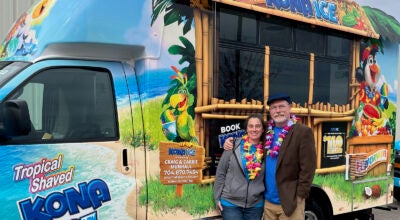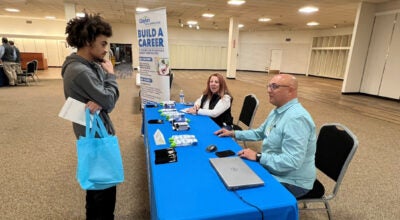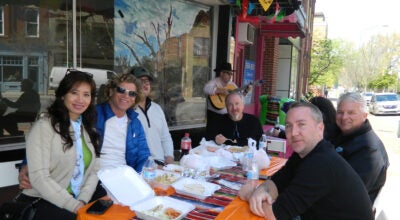Artcraft tries to keep neon alive
Published 12:00 am Saturday, October 13, 2012
By Emily Ford
eford@salisburypost.com
SALISBURY – Artcraft Neon in Salisbury practices a dying art.
The Julian Road business is one of a handful left in North Carolina that creates neon signs by blowing and bending glass tubes into dramatic curves and shapes, then filling them with gases that glow when electrified.
“Neon is sentimental because it told you where to sleep and showed you places to eat,” said Artcraft co-owner Brent Nicholas, a third-generation neon bender. “It was always in the background. Everywhere, you’d see it.”
Neon is less ubiquitous now, increasingly replaced by signs lit with high-tech LED bulbs.
The change has hurt signmakers like Nicholas and his wife, Paulette, who have owned and operated Artcraft since 1985.
At the peak of their business in the mid-1990s, Artcraft employed five full-time neon benders. Neon was just about all Artcraft produced.
Now, the company has two part-time employees, plus Brent and Paulette Nicholas. Neon makes up about 50 percent of the business.
About six years ago, the Nicholases saw neon losing favor and began adding other products to their line-up, including channel letter signs, vinyl letter signs and sublimation printing (putting a photograph or logo on a mouse pad, water bottle, coffee mug or other item).
But neon remains their passion.
Brent Nicholas blows the glass, bending the hot tubes to fit a pattern created using computer software. Letters on the pattern are backward, and after more than 30 years of bending neon, Brent can read from right to left as well as he reads from left to right.
Paulette Nicholas uses a processing unit to vacuum out impurities and then fill the tubes with either neon (reds and pinks) or argon (blues and purples) gas. Argon requires a small amount of mercury to light up.
Artcraft will install neon inside channel or cabinet letters, like the sign at Capriano’s restaurant near Lowe’s. Or they will create an exposed neon sign, like the one at Casa Grande.
Artcraft made the large fish-loaf-apple neon sign atop the Salisbury Harris Teeter, as well as the logo at about 40 other stores in the grocery chain.
Harris Teeter likes the look of exposed neon, Brent said, as he recently fashioned an “e” that will appear in the “deli” sign at one of its stores.
A wholesaler, Artcraft provides neon to sign companies. But Artcraft has turned more to retail as the economic downturn continues.
Before the Great Recession, Artcraft was bidding on 20 to 30 new jobs each week. If the company won 10 percent, the Nicholases were swamped.
Now, a week will go by without a single bid.
“We have had to cut everything to the bone,” Brent said. “I’m 50 and I have never seen the economy this bad for this long.”
While LED lighting takes little skill to install, neon can require years to master. Every neon sign is handmade and one-of-a-kind.
Brent’s grandfather, Harvey Faries, began bending neon in the 1920s in Indiana. His son, Richard Faries, took up the craft and after World War II, traveled around the country making neon signs.
He eventually set up shop in Concord and began teaching his son, Brent, to bend neon when he was in high school.
After four years in the Marines, Brent returned to the trade and went into the family business.
Artcraft’s largest customer was Everglo Signs, located on U.S. Highway 29 where the Foxy Lady now stands.
Everglo owner Joe Gainer moved Artcraft to Salisbury and sold the family an acre of land on Julian Road for their operation. Through Everglo, Artcraft provided all the neon for Food Lion, starting in 1985.
Food Lion no longer uses neon, Brent said, but the nostalgic look of exposed neon may be making a comeback elsewhere.
CNN used exposed neon for the CNN Cafe sign at the Republican National Convention in Tampa. But before the media outlet moved the sign to the Democratic National Convention in Charlotte two weeks later, someone broke it.
Artcraft was able to recreate the neon sign in time for the convention.
The company’s work is also evident on the Meroney Theater, Hap’s Grill and Spanky’s in downtown Salisbury, as well as Inksane and Danny’s Place in Rockwell.
Now, Artcraft plans to market new ways to use neon, including as house numbers inside a plexiglass box. Neon can light up a driveway border or encircle a pool.
“You can bend a piece of neon anyway you want,” Paulette said.
British scientists discovered neon as an element in 1898. Georges Claude in 1902 created the first neon bulb when he charged a sealed tube of glass containing the inert gas with an electrical current.
Neon appeared in a modern form in 1910 at the Paris Motor Show and arrived in the U.S. in 1923 at a Los Angeles auto dealership.There were nearly 2,000 small shops producing neon signs by 1940.
While neon seems to be dying a slow death, some companies unsatisfied with stark LED signs have come back to neon.
About 10 percent of Artcraft’s neon work is replacing LEDs with glass tubes of glowing gas.
Contact reporter Emily Ford at 704-797-4264.




